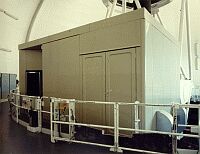William Herschel
Telescope
Ground-based High Resolution Imaging
Laboratory (GHRIL)

First light: 11 April 1988
De-commissioned:
Designed and built by: NFRA,
RGO, IAC.
Description: The GHRIL
laboratory consists of a cabin on one of the Nasmyth platforms of the WHT.
The cabin has an optics laboratory measuring approximately 3.5×3.5
metres, into which the WHT f/11 beam can be directed, and a room for control
of the telescope and the equipment in the laboratory. The laboratory includes
an optical table and compatible optical components. This facility, which
is unique for a large optical telescope, can be used to set up special
equipment or optical experiments for relatively short periods of time.
The optics laboratory contains a 1350×2500 mm optical table and a
range of optical components. The beam entering GHRIL is f/11 and the image
scale at the Nasmyth focus is 4.465 arcseconds per mm aproximately. The
unvignetted field of view is 2.5 arcminutes.
Many instruments have been set up at GHRIL for a short period of time.
However others have used GHRIL as their permanent house and they are
reported in other web pages.
Below are some examples of own instruments that have taken advantage of the high-resolution capabilities and isolated environment conditions of GHRIL:
- The TRANSPUTER project. The TRANSPUTER project aims at producing
image sharpening on-line using a network of fixed and floating point
TRANSPUTERS. The objective of the project is to avoid the data storage
problems inherent in recording the addresses and times of individual photons
for off-line reduction, and to produce sharp images in time for the
astronomer to react while still having access to the telescope. The data is
collected from an Imaging Photon counting Device (IPD) behind a
collimator/camera system designed to allow the aperture of the telescope to
be varied to take account of the seeing conditions. First light was in April
1988 and the experiment was designed by the Instituto de Astrofísica
de Canarias and University College Galway, Ireland.
- The infrared group at the IAC undertook near-infrared photometric
observations of one of the brightest supernovae to appear in northern
declinations for decades: SN 1993J. The project was used to demostrate that
daytime (meaning 2-3 hours before sunset or after sunrise) observations in
the infrared on the GHRIL platform are an entirely practicable proposition
and in no way interfere with the requirements of the scheduled nocturnal
observer. For this experiment the astronomers used the single-channel Oxford
cryostat from the Carlos Sánchez Telescope on Tenerife, with JKHL'M
broad-band filters.
- Interferometric observations of Betelgeuse were made in 1997 at GHRIL. These used the non-redundant aperture masking method and employed an optical arrangement in which a pupil-plane mask, opaque save for a non-redundant array of holes, is used to select a set of Fourier components for measurement. The resulting interference fringes were imaged on to a CCD and recorded at 12-ms intervals using on-chip binning to compress each two-dimensional snapshot into a single row of data. A linear five-hole mask was used, giving 10 baselines with lengths ranging between 0.3 and 3.7 nm.
Some scientific highlights:
More photos of this instrument: http://www.ing.iac.es/PR/archive/wht/instruments.html
|



